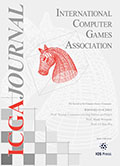Authors: Wolf, Thomas
Article Type:
Research Article
Abstract:
Seki positions of the game of Go that are discussed in this paper involve only chains with 2 liberties with the minor generalization of what will be called ‘negligible’ 1- or 2-stone chains with 1 liberty sitting in a 1-chain eye. There are no kos in the seki and no kos can result from play in the seki. Any move, other than capturing a negligible chain or filling a 1-point eye composed of multiple chains of same color and thus linking these chains, would result in the instant capture of the placed stone, and its attached chain of the same
…color. Also, the captured chain must be large enough, and of the right shape, such that the captured player then loses, without even the possibility of any type of ko, like ‘mannen ko’. Therefore, ‘throw-in ko’, and sacrifices of ‘Nakade’ shapes, and positions like ‘bent 4 in the corner’, are excluded. We call the remaining, simplest, permitted positions Basic Seki. The article starts with describing deformations of seki positions that do not change the essential structure of a seki which is summarized in a so-called Basic Seki Graph. By using such graphs it is shown that all chains which share some liberty, say A , can have in total at most two more liberties other than A . As a consequence Basic Seki have either a linear or a circular topology. Furthermore, if the position has >2 empty points, then there can be at most 3 chains which have the same 2 empty points as liberties and, moreover, these chains need to have the same color. These properties allow us to recognise Basic Seki, after 1) verifying that sacrificing any chain leads to an unconditional loss, and then 2) verifying the above properties of Basic Seki. These properties are all local, so that the total effort goes linearly with the number of liberties and chains that are involved if that number gets large. Based on the necessary and sufficient properties of Basic Seki, a numerical encoding of any Basic Seki is possible that allows a straightforward algorithm for formulating all possible topologies of Basic Seki and thus for creating any Basic Seki position. An approximate formula for the number of different topologies of Basic Seki has been derived. Finally, examples of modifications of seki positions are shown that change their Basic Seki Graph. The resulting positions are used to illustrate the numerical encoding of their topology.
Show more
Keywords: Game Go, Seki, Computer Go, Topology in Go, Mathematical Go
DOI: 10.3233/ICG-170011
Citation: ICGA Journal,
vol. 39, no. 2, pp. 102-122, 2017
Price: EUR 27.50





